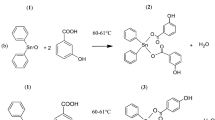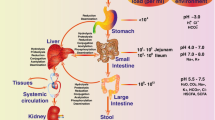Abstract
Three metabolites of the cytotoxic drug paclitaxel (Taxol) were isolated and purified from the feces of cancer patients receiving the agent as an intravenous infusion. The procedures involved sample homogenization in water followed by liquid-liquid extraction with diethyl ether and high-performance liquid chromatography (HPLC). Approximately 1–3.5 mg of each metabolite was obtained from 100 g of feces. As judged from the chromatographic traces of analytical HPLC with ultraviolet (UV) detection at 227 nm, the purity of each compound was >97%. On-line photodiode-array detection demonstrated that the UV spectrum of the isolated compounds closely resembles that of the parent drug. Mass spectrometry provided evidence that these metabolites are mono- and dihydroxy-substituted derivatives, namely, 6α-hydroxypaclitaxel, 3′-p-hydroxypaclitaxel, and 6α,3′-p-dihydroxypaclitaxel. The two 6α-hydroxy-substituted metabolites were shown to have lost their cytotoxicity in in vitro clonogenic assays using the A2780 human ovarian carcinoma and the CC531 rat colon-carcinoma tumor cell lines. In addition, the metabolites showed reduced myelotoxic effects as compared with paclitaxel in an in vitro hemopoietic progenitor toxicity assay. Our procedure for the isolation and purification of paclitaxel metabolites in milligram quantities should be useful for testing the biological activities of these compounds and for the preparation of calibration standards essential for pharmockinetics studies.
Similar content being viewed by others
References
Brown T, Havlin K, Weiss G, Cagnola J, Koeller J, Kuhn J, Rizzo J, Craig J, Phillips J, Von Hoff D (1991) A phase I trial of taxol given by a 6-hour intravenous infusion. J Clin Oncol 9: 1261
Chang A, Kim K, Glick J, Anderson T, Karp D, Johnson D (1992) Phase II study of taxol in patiens with stage IV non-small cell lung cancer (NSCLC): the Eastern Cooperative Oncology Group (ECOG) results. Proc Am Soc Clin Oncol 11: 293
Harris JW, Katki A, Anderson LW, Chmurny GN, Paukstelis JV, Collins JM (1994) Isolation, structural determination, and biological activity of 6α-hydroxytaxol, the principal human metabolite of taxol. J Med Chem 37: 706
Holmes FA, Walters RS, Theriault RL, Forman AD, Newton LK, Raber MN, Buzdar AU, Frye DK, Hortobagyi GN (1991) Phase II trial of taxol, an active drug in the treatment of metastatic breast cancer. J Natl Cancer Inst 83: 1797
Horwitz SB, Lothstein L, Manfredi JJ, Mellado W, Parness J, Roy SN, Schiff PB, Sorbata L, Zeheb R (1986) Taxol: mechanisms of action and resistance. Ann NY Acad Sci 466: 733
Huizing MT, Keung ACF, Rosing H, Kuji V van der, Bokkel Huinink WW ten, Mandjes IM, Dubbelman AC, Pinedo HM, Beijnen JH (1993) Pharmacokinetics of paclitaxel and metabolites in a randomized comparative study in platinum-pretreated ovarian cancer patients. J Clin Oncol 11: 2127
Jamis-Dow CA, Klecker RW, Katki AG, Collins JM (1993) Metabolism of taxol by human liver microsomes and effect of inhibitors (abstract). Proc Am Assoc Cancer Res 34: 369
Kumar GN, Oatis JE, Thornburg KR, Heldrich FJ, Starr Hazard E, Walle T (1994) 6α-Hydroxytaxol: isolation and identification of the major metabolite of taxol in human liver microsomes. Drug Metab Dispos 22: 177
Longnecker SM, Donehower RC, Cates AE, Chen T-L, Brundrett RB, Grochow LB, Ettinger DS, Colvin M (1987) High-performance liquid chromatographic assay for taxol in human plasma and urine and pharmacokinetics in a phase I trial. Cancer Treat Rep 71: 53
Markman M, Rowinsky EK, Hakes T, Reichman B, Jones W, Lewis JL, Rubin S, Curtin J, Barakat R, Phillips M, Hurowitz L, Almadrones L, Hoskins W (1992) Phase I trial of intraperitoneal taxol: a Gynecologic Oncology Group study. J Clin Oncol 10: 1485
McGuire WP, Rowinsky EK, Rosenshein NB, Grumbine FC, Ettinger DS, Armstrong DK, Donehower RC (1989) Taxol: a unique antineoplastic agent with significant activity in advanced ovarian epithelial neoplasms. Ann Intern Med 111: 273
Monsarrat B, Mariel E, Cros S, Garès M, Guénard D, Guéritte-Voegelein F, Wright M (1990) Taxol metabolism. Isolation and identification of three major metabolites of taxol in rat bile. Drug Metab Dispos 18: 895
Monsarrat B, Alvinerie P, Wright M, Dubois J, Guéritte-Voegelein F, Guénard D, Rowinsky EK, Donehower RC (1993) Hepatic metabolism and biliary clearance of taxol in rats and humans. Natl Cancer Inst Monogr 15: 39
Rowinsky EK, Donehower RC (1992) Clinical pharmacologic studies of the antimicrotubule agent taxol (abstract). Ann Oncol 3 [suppl 1]: 119
Rowinsky EK, Burke PJ, Karp JE, Tucker RW, Ettinger DS, Donehower RC (1989) Phase I and pharmacodynamic study of taxol in refractory acute leukemias. Cancer Res 49: 4640
Rowinsky EK, Cazenave LA, Donehower Rc (1990) Taxol: a novel investigational antimicrotubule agent. J Natl Cancer Inst 82: 1247
Schiff PB, Fant J, Horwitz SB (1979) Promotion of microtubule assembly in vitro by taxol. Nature 277: 665
Van Beusechem VW, Kukler A, Heidt PJ, Valerio D (1992) Long-term expression of human adenosine deaminase in rhesus monkeys transplanted with retrovirus-infected bone marrow cells. Proc Natl Acad Sci USA 89: 7640
Walle T, Kumar GN, McMillan JM, Thornburg KR, Walle UK (1993) Taxol metabolism in rat hepatocytes. Biochem Pharmacol 49: 1661
Wani MC, Taylor HL, Wall ME, Coggon P, McPhail AT (1971) Plant antitumor agents. VI. The isolation and structure of taxol, a novel antileukemic and antitumor agent fromTaxus brevifolia. J Am Chem Soc 93: 2325
Wiernik PH, Schwartz EL, Strauman JJ, Dutcher JP, Lipton RB, Paietta E (1987) Phase I clinical and pharmacokinetic study of taxol. Cancer Res 47: 2486
Willey TA, Bekos EJ, Gaver RC, Duncan GF, Tay LK, Beijnen JH, Farman RH (1993) High-performance liquid chromatographic procedure for the quantitative determination of paclitaxel (Taxol) in human plasma. J Chromatogr 621: 231
Author information
Authors and Affiliations
Rights and permissions
About this article
Cite this article
Sparreboom, A., Huizing, M.T., Boesen, J.J.B. et al. Isolation, purification, and biological activity of mono- and dihydroxylated paclitaxel metabolites from human feces. Cancer Chemother. Pharmacol. 36, 299–304 (1995). https://doi.org/10.1007/BF00689047
Received:
Accepted:
Issue Date:
DOI: https://doi.org/10.1007/BF00689047




